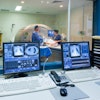It's not going to take over the world yet, but 3-tesla MRI is coming -- and coming on strong. Over the next several years, as the price of these systems begins to fall, many facilities that reluctantly joined the 1.5-tesla world will again feel the mounting market pressure to upgrade.
The pressure is already on. Facilities across the country are plunking down millions of dollars for 3-tesla systems in hopes of establishing a reputation as the leading healthcare provider in their region. It has become a mark of distinction for those facilities that have them -- at least that's what administrators and public relations staff hope the public believes. But apart from the millions of dollars of new capital expense, it's just a question of moving out the old and moving in the new, right?
Wrong. Despite the fact that many manufacturers of 3-tesla systems wrap their magnets in plastic shells that are nearly identical to their 1.5-tesla systems, the similarity of appearance does not mean equal siting considerations. There are a number of factors you should address before making the decision to upgrade or expand to include a 3-tesla system in your facility.
First, the good news: The active shielding on most new 3-tesla magnets does an excellent job of restraining the magnetic field. The 5-gauss exclusion zone can still be sited completely within a moderate-size magnet room, despite the doubling of the magnet's power.
Now for the bad news: Even though the Food and Drug Administration (FDA) exclusion zone for 3-tesla magnets can often be contained within the magnet room, the fringing field for these magnets spills significantly farther than that of their 1.5-tesla siblings.
This extended fringing field may interfere with nearby PET, CT, and other nuclear medicine equipment that wasn't affected by the half-powered magnet. The magnetic fringe field could, if these other modalities are adjacent to the magnet room, degrade their images or even render the equipment inoperable.
Another major siting consideration is how your 3-tesla magnet's active shielding can fail. If the active shielding coils shut down, but the primary imaging magnets remain at field even for a short period, the magnetic field will suddenly bloom to several times its normal size. The increased size of the bloom field, and the way in which the system handles active shielding failure, could have life-threatening consequences compared to a 1.5-tesla system.
While the active shielding is excellent at "girdling" the magnetic field, it also dramatically increases the rate at which the field strength increases (gradient) as you approach the magnet. This means that the distance between the magnet gently pulling on the ferrous wheelchair you're pushing and the magnet ripping it from your grasp and jamming it down the bore is greatly compressed. Missile-effect events, such as the one that killed Michael Colombini at the Westchester Medical Center in Valhalla, NY, may be more likely and more dangerous with 3-tesla systems.
To address the siting, multimodal, and safety issues associated with a planned (or even wished) upgrade to a 3-tesla system, you should get professional design assistance from a qualified third party, someone other than the vendor. An MRI or facility safety analysis and siting consultation could save you significant amounts of time and money by preventing major siting mistakes and improving facility safety for patients and staff.
A short list of siting considerations should include the following:
FDA exclusion zones (5-gauss limits) are similar, although tends to be a little larger for 3-tesla magnets.
A 3-tesla fringe field (magnetic field strengths between 0.5 gauss and 5 gauss) spreads much farther than a 1.5-tesla fringe field.
The fringe field can interfere with other modalities (CT, PET, nuclear medicine) and computerized equipment (PACS, EMR servers, and so on). Just because it worked with your 1.5-tesla system doesn't mean existing equipment will work near a 3-tesla unit.
The 3-tesla bloom field (in units in which active shielding can fail independently) is significantly larger than bloom fields for 1.5-tesla units.
Failure modes must be scrutinized and patient, staff, and public populations within the bloom-field volume must be evaluated.
Equipment with 1-gauss or greater bloom-field volume must be evaluated for potential interference.
- Shielding, even if the original specs meet the demands for the new magnet, must be tested and verified by a third party prior to new magnet installation.
- Vibration requirements may be different, or environmental factors may have changed since the last time the facility was tested. Have a vibration analysis done.
- The 3-tesla gradients are so strong that a new magnet calls for a full-suite safety evaluation and audit to ensure that screening protocols, access controls, layout, and patient visualization are appropriately addressed. What may have been a close call for a 1.5-tesla unit could easily be a major incident with a 3-tesla system.
- All MR-safe and MR-compatible equipment must be reviewed for safety and operation at increased field strength.
- While you have the magnet room empty, this is the perfect opportunity to add elements to enable additional functionality, including interventional care (laser simulation, hand sinks, procedure lights) as appropriate to your facility.
If 3-tesla MRI may be in your future, now is the time to get professional advice to help you plan appropriately to protect your patients, your staff, and your investment.
By Tobias Gilk
AuntMinnie.com contributing writer
January 27, 2005
Reprinted from www.mri-planning.com by permission of the authors. If you would like more information on any aspect of MR facility design or safety, please contact Robert Junk or Tobias Gilk at Jünk Architects.
Related Reading
Chilled loop failure: How to break your magnet without even trying, December 8, 2004
HIPAA compliance strategies for MR control rooms, October 26, 2004
The fire extinguisher in your MRI suite: will it save a life or take one? September 22, 2004
What your vendor may not have told you about magnetic contamination, July 27, 2004
Universal room design can mitigate change costs, May 16, 2003
Copyright © 2005 Jünk Architects, PC


.fFmgij6Hin.png?auto=compress%2Cformat&fit=crop&h=100&q=70&w=100)





.fFmgij6Hin.png?auto=compress%2Cformat&fit=crop&h=167&q=70&w=250)











